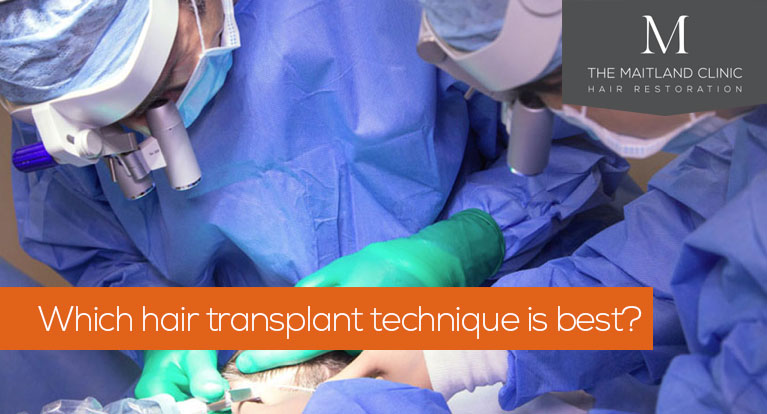Which hair transplant technique is best?
3rd August 2019

With a number of hair transplant techniques now available, at The Maitland Clinic we are often asked ‘which technique is best?’ While each method can produce natural looking results, as this post explains, the best treatment for you will depend on a range of factors.
The two principal hair transplant techniques are Follicular Unit Transplant (FUT) or ‘strip’; and Follicular Unit Excision (FUE). Each method has its own advantages and the best technique will depend on the individual patient and their particular circumstances. The experienced team at The Maitland Clinic will discuss the pros and cons with you to help you decide on the most suitable course of treatment.
What is the difference between FUT and FUE?
The main difference between the FUT and FUE procedures is the way in which the donor hair is harvested. During the FUT process the surgeon removes a healthy strip of hair-bearing skin from the donor, usually from the back of their head. The strip is then divided into tiny grafts of individual follicular units comprised of one to four hairs. FUE, however, utilises the latest technology to extract individual follicular units directly from the scalp. The process is carried out using a 0.8mm to 1mm ‘punch’ device.
In both cases our leading surgeon, Dr Edward Ball, will then implant the hair grafts into the balding areas of the patient’s scalp with great care, precision and artistry to create a natural look. You can read more about the FUT and FUE techniques on our website.
FUT versus FUE: which technique is best?
Both FUT and FUE can achieve excellent results, but each method has its pros and cons. The best option will depend on the extent and characteristics of the hair loss, the quality and quantity of donor hair, as well as the final look you are hoping to achieve.
Some of the advantages of FUT are:
- Greater yield – In many cases FUT will produce a higher yield of hair then FUE. This is because all of the hair is harvested from the mid-portion of the donor area where the hair is most permanent and usually most abundant. FUT may therefore be ideal for those patients requiring a large number of grafts.
- Majority of hair does not need to be shaved – Unlike FUE, which usually requires the patient to shave at least the sides and back of their head, the FUT technique means the majority of hair can be left long. This may be ideal for patients needing to return to work quickly or those in the public eye.
- Shorter time in surgery – The process of extracting individual grafts for FUE means patients can spend a significant amount of time in surgery (up to two days in some cases). However, the FUT procedure usually takes between four and ten hours, depending on the quantity of grafts that need to be transplanted.
- Less expensive than FUE – In most cases an FUT procedure will cost less than an FUE hair transplant.
Some of the advantages of FUE include:
- Minimal scarring – The FUT technique leaves a linear scar which can require hair to be worn at a grade 4 or longer to conceal it. FUE leaves only a series of tiny dot scars which are so small that they can be difficult to find with the naked eye, unless the hair is shaved below a grade 1.
- Short recovery time – The small holes left by FUE do not need to be stitched and will usually heal by themselves in a few days. This means there are fewer limitations on returning to strenuous activity following surgery.
- Can keep hair short – As the FUE technique leaves dot scarring that can be hardly noticeable, patients can choose to have a short haircut if they prefer, often as short as a number one or two cut.
- Ideal for small transplants – FUE may be preferable for those patients requiring only a small number of grafts, or for younger recipients in the early stages of hair loss.
The good news is that both the FUT and FUE techniques require only a local anaesthetic and most of our patients report minimal discomfort once the numbing injections are completed.
How successful is a hair transplant in most cases?
As one of the world’s top surgeons for hair restoration, Dr Edward Ball has an excellent reputation for delivering successful FUT and FUE hair transplants. However, the results will depend on a number of factors unique to the patient, such as the extent of the hair loss, the characteristics of the hair and the size of their head. The density of hair in the donor area will also affect the supply of follicular units.
The Maitland Clinic will always be honest about the chance of success. Unlike many other clinics, we will only recommend a treatment if we believe you are a suitable candidate and there is a high chance of achieving a positive outcome. You can view some of our success stories in our gallery.
Other techniques: non-surgical hair restoration
For patients in the early stages of hair loss, a non-surgical technique may be preferable to a hair transplant. The Maitland Clinic offers a number of non-surgical hair restoration treatments. These include:
- Medication – For those experiencing the early signs of hair loss, medication such as finasteride can slow or even reverse the hair loss process. Finasteride is often used by men in the early stages of male pattern baldness and can produce particularly good results in the crown and mid-scalp areas. Alternatively, minoxidil can be applied to the scalp to improve blood flow to the hair follicles. Unlike finasteride, it can be used by men and women and is usually available without a prescription.
- Laser treatment – The Maitland Clinic can carry out low-level laser therapy either at our practice or in your own home. The technique works by applying a laser light to the scalp to improve blood flow to the hair follicles and stimulate cell metabolism.
- Platelet-Rich Plasma (PRP) – As a form of ‘biotherapy’, PRP treatment utilises the body’s ability to heal and repair itself. The process involves injecting areas of a patient’s scalp with a concentrated sample derived from their own blood. There is growing evidence that the technique can stimulate hair growth in many people, although it is important to note that this is a relatively new treatment for hair loss and success rates do vary.
- Trichopigmentation – Scalp trichopigmentation (STP), or scalp micropigmentation (SMP), is a cosmetic treatment during which tiny dots of ink are applied to the scalp. This ink is carefully matched to the patient’s hair colour to create a temporary or permanent impression of increased hair density and coverage.
These techniques may be used in isolation or in combination with a hair transplant, as agreed with your clinician.
Hair restoration at The Maitland Clinic
The Maitland Clinic has an excellent reputation for delivering successful FUT and FUE hair transplants, along with other non-surgical techniques. If you are considering hair restoration, our experienced team can talk through the options with you to determine the best course of treatment.
We take patient care very seriously and our exemplary aftercare service means you will receive ongoing support throughout your treatment – and beyond.
To arrange a consultation please contact us or call on 02392 706 122.











